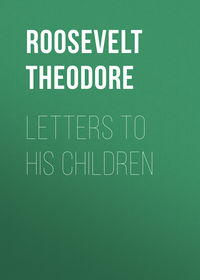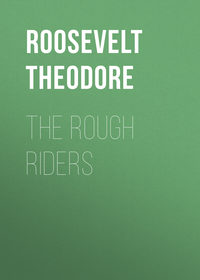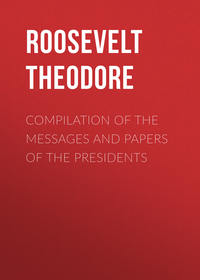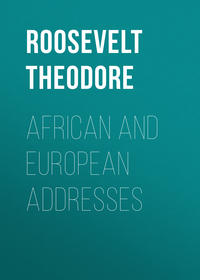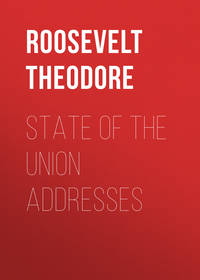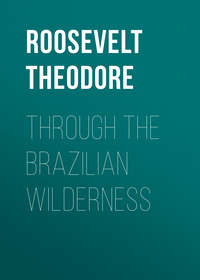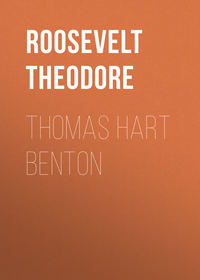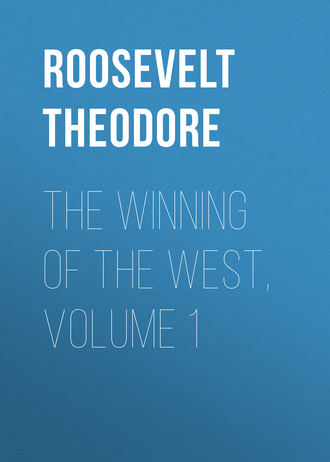 полная версия
полная версияThe Winning of the West, Volume 1
Many of the chiefs owned droves of horses and horned cattle, sometimes as many as five hundred head,54 besides hogs and poultry; and some of them, in addition, had negro slaves. But the tillage of the land was accomplished by communal labor; and, indeed, the government, as well as the system of life, was in many respects a singular compound of communism and extreme individualism. The fields of rice, corn, tobacco, beans, and potatoes were sometimes rudely fenced in with split hickory poles, and were sometimes left unfenced, with huts or high scaffolds, where watchers kept guard. They were planted when the wild fruit was so ripe as to draw off the birds, and while ripening the swine were kept penned up and the horses were tethered with tough bark ropes. Pumpkins, melons, marsh-mallows, and sunflowers were often grown between the rows of corn. The planting was done on a given day, the whole town being summoned; no man was excepted or was allowed to go out hunting. The under-headman supervised the work.55
For food they used all these vegetables, as well as beef and pork, and venison stewed in bear's oil; they had hominy and corn-cakes, and a cool drink made from honey and water,56 besides another made from fermented corn, which tasted much like cider.57 They sifted their flour in wicker-work sieves, and baked the bread in kettles or on broad, thin stones. Moreover, they gathered the wild fruits, strawberries, grapes, and plums, in their season, and out of the hickory-nuts they made a thick, oily paste, called the hickory milk.
Each town was built round a square, in which the old men lounged all day long, gossiping and wrangling. Fronting the square, and surrounding it, were the four long, low communal houses, eight feet high, sixteen feet deep, and forty to sixty in length. They were wooden frames, supported on pine posts, with roof-tree and rafters of hickory. Their fronts were open piazzas, their sides were lathed and plastered, sometimes with white marl, sometimes with reddish clay, and they had plank doors and were roofed neatly with cypress bark or clapboards. The eave boards were of soft poplar. The barrier towns, near white or Indian enemies, had log houses, with portholes cut in the walls.
The communal houses were each divided into three rooms. The House of the Micos, or Chiefs and Headmen, was painted red and fronted the rising sun; it was highest in rank. The Houses of the Warriors and the Beloved Men—this last being painted white—fronted south and north respectively, while the House of the Young People stood opposite that of the Micos. Each room was divided into two terraces; the one in front being covered with red mats, while that in the rear, a kind of raised dais or great couch, was strewn with skins. They contained stools hewed out of poplar logs, and chests made of clapboards sewed together with buffalo thongs.58
The rotunda or council-house stood near the square on the highest spot in the village. It was round, and fifty or sixty feet across, with a high peaked roof; the rafters were fastened with splints and covered with bark. A raised dais ran around the wall, strewed with mats and skins. Sometimes in the larger council-houses there were painted eagles, carved out of poplar wood, placed close to the red and white seats where the chiefs and warriors sat; or in front of the broad dais were great images of the full and the half moon, colored white or black; or rudely carved and painted figures of the panther, and of men with buffalo horns. The tribes held in reverence both the panther and the rattlesnake.
The corn-cribs, fowl-houses, and hot-houses or dugouts for winter use were clustered near the other cabins.
Although in tillage they used only the hoe, they had made much progress in some useful arts. They spun the coarse wool of the buffalo into blankets, which they trimmed with beads. They wove the wild hemp in frames and shuttles. They made their own saddles. They made beautiful baskets of fine cane splints, and very handsome blankets of turkey feathers; while out of glazed clay they manufactured bowls, pitchers, platters, and other pottery.
In summer they wore buckskin shirts and breech-clouts; in winter they were clad in the fur of the bear and wolf or of the shaggy buffalo. They had moccasins of elk or buffalo hide, and high thigh-boots of thin deer-skin, ornamented with fawns' trotters, or turkey spurs that tinkled as they walked. In their hair they braided eagle plumes, hawk wings, or the brilliant plumage of the tanager and redbird. Trousers or breeches of any sort they despised as marks of effeminacy.
Vermilion was their war emblem; white was only worn at the time of the Green-Corn Dance. In each town stood the war pole or painted post, a small peeled tree-trunk colored red. Some of their villages were called white or peace towns; others red or bloody towns. The white towns were sacred to peace; no blood could be spilt within their borders. They were towns of refuge, where not even an enemy taken in war could be slain; and a murderer who fled thither was safe from vengeance. The captives were tortured to death in the red towns, and it was in these that the chiefs and warriors gathered when they were planning or preparing for war.
They held great marriage-feasts; the dead were buried with the goods they had owned in their lifetime.
Every night all the people of a town gathered in the council-house to dance and sing and talk. Besides this, they held there on stated occasions the ceremonial dances; such were the dances of war and of triumph, when the warriors, painted red and black, returned, carrying the scalps of their slain foes on branches of evergreen pine, while they chanted the sonorous song of victory; and such was the Dance of the Serpent, the dance of lawless love, where the women and young girls were allowed to do whatsoever they listed.
Once a year, when the fruits ripened, they held the Green-Corn Dance, a religious festival that lasted eight days in the larger towns and four in the smaller. Then they fasted and feasted alternately. They drank out of conch-shells the Black Drink, a bitter beverage brewed from the crushed leaves of a small shrub. On the third day the high-priest or fire-maker, the man who sat in the white seat, clad in snowy tunic and moccasins, kindled the holy fire, fanning it into flames with the unsullied wing of a swan, and burning therein offerings of the first-fruits of the year. Dance followed dance. The beloved men and beloved women, the priest and priestesses, danced in three rings, singing the solemn song of which the words were never uttered at any other time; and at the end the warriors, in their wild war-gear, with white-plume headdresses, took part, and also the women and girls, decked in their best, with ear-rings and armlets, and terrapin shells filled with pebbles fastened to the outside of their legs. They kept time with foot and voice; the men in deep tones, with short accents, the women in a shrill falsetto; while the clay drums, with heads of taut deer-hide, were beaten, the whistles blown, and the gourds and calabashes rattled, until the air resounded with the deafening noise.59
Though they sometimes burnt their prisoners or violated captive women, they generally were more merciful than the northern tribes.60
But their political and military systems could not compare with those of the Algonquins, still less with those of the Iroquois. Their confederacy was of the loosest kind. There was no central authority. Every town acted just as it pleased, making war or peace with the other towns, or with whites, Choctaws, or Cherokees. In each there was a nominal head for peace and war, the high chief and the head warrior; the former was supposed to be supreme, and was elected for life from some one powerful family—as, for instance, the families having for their totems the wind or the eagle. But these chiefs had little control, and could not do much more than influence or advise their subjects; they were dependent on the will of the majority. Each town was a little hotbed of party spirit; the inhabitants divided on almost every question. If the head-chief was for peace, but the war-chief nevertheless went on the war-path, there was no way of restraining him. It was said that never, in the memory of the oldest inhabitant, had half the nation "taken the war talk" at the same time.61 As a consequence, war parties of Creeks were generally merely small bands of marauders, in search of scalps and plunder. In proportion to its numbers, the nation never, until 1813, undertook such formidable military enterprises as were undertaken by the Wyandots, Shawnees, and Delawares; and, though very formidable individual fighters, even in this respect it may be questioned if the Creeks equalled the prowess of their northern kinsmen.
Yet when the Revolutionary war broke out the Creeks were under a chieftain whose consummate craft and utterly selfish but cool and masterly diplomacy enabled them for a generation to hold their own better than any other native race against the restless Americans. This was the half-breed Alexander McGillivray, perhaps the most gifted man who was ever born on the soil of Alabama.62
His father was a Scotch trader, Lachlan McGillivray by name, who came when a boy to Charleston, then the head-quarters of the commerce carried on by the British with the southern Indians. On visiting the traders' quarter of the town, the young Scot was strongly attracted by the sight of the weather-beaten packers, with their gaudy, half-Indian finery, their hundreds of pack-horses, their curious pack-saddles, and their bales of merchandise. Taking service with them, he was soon helping to drive a pack-train along one of the narrow trails that crossed the lonely pine wilderness. To strong, coarse spirits, that were both shrewd and daring, and willing to balance the great risks incident to their mode of life against its great gains, the business was most alluring. Young Lachlan rose rapidly, and soon became one of the richest and most influential traders in the Creek country.
Like most traders, he married into the tribe, wooing and wedding, at the Hickory Ground, beside the Coosa River, a beautiful half-breed girl, Sehoy Marchand, whose father had been a French officer, and whose mother belonged to the powerful Creek family of the Wind. There were born to them two daughters and one son, Alexander. All the traders, though facing danger at every moment, from the fickle and jealous temper of the savages, wielded immense influence over them, and none more than the elder McGillivray, a far-sighted, unscrupulous Scotchman, who sided alternately with the French and English interests, as best suited his own policy and fortunes.
His son was felt by the Creeks to be one of themselves. He was born about 1746, at Little Tallasee, on the banks of the clear-flowing Coosa, where he lived till he was fourteen years old, playing, fishing, hunting, and bathing with the other Indian boys, and listening to the tales of the old chiefs and warriors. He was then taken to Charleston, where he was well educated, being taught Greek and Latin, as well as English history and literature. Tall, dark, slender, with commanding figure and immovable face, of cool, crafty temper, with great ambition and a keen intellect, he felt himself called to play no common part. He disliked trade, and at the first opportunity returned to his Indian home. He had neither the moral nor the physical gifts requisite for a warrior; but he was a consummate diplomat, a born leader, and perhaps the only man who could have used aright such a rope of sand as was the Creek confederacy.
The Creeks claimed him as of their own blood, and instinctively felt that he was their only possible ruler. He was forthwith chosen to be their head chief. From that time on he remained among them, at one or the other of his plantations, his largest and his real home being at Little Tallasee, where he lived in barbaric comfort, in a great roomy log-house with a stone chimney, surrounded by the cabins of his sixty negro slaves. He was supported by many able warriors, both of the half and the full blood. One of them is worthy of passing mention. This was a young French adventurer, Milfort, who in 1776 journeyed through the insurgent colonies and became an adopted son of the Creek nation. He first met McGillivray, then in his early manhood, at the town of Coweta, the great war-town on the Chattahoochee, where the half-breed chief, seated on a bear-skin in the council-house, surrounded by his wise men and warriors, was planning to give aid to the British. Afterwards he married one of McGillivray's sisters, whom he met at a great dance—a pretty girl, clad in a short silk petticoat, her chemise of fine linen clasped with silver, her ear-rings and bracelets of the same metal, and with bright-colored ribbons in her hair.63
The task set to the son of Sehoy was one of incredible difficulty, for he was head of a loose array of towns and tribes from whom no man could get perfect, and none but himself even imperfect, obedience. The nation could not stop a town from going to war, nor, in turn, could a town stop its own young men from committing ravages. Thus the whites were always being provoked, and the frontiersmen were molested as often when they were quiet and peaceful as when they were encroaching on Indian land. The Creeks owed the land which they possessed to murder and rapine; they mercilessly destroyed all weaker communities, red or white; they had no idea of showing justice or generosity towards their fellows who lacked their strength, and now the measure they had meted so often to others was at last to be meted to them. If the whites treated them well, it was set down to weakness. It was utterly impossible to restrain the young men from murdering and plundering, either the neighboring Indians or the white settlements. Their one ideal of glory was to get scalps, and these the young braves were sure to seek, no matter how much the older and cooler men might try to prevent them. Whether war was declared or not, made no difference. At one time the English exerted themselves successfully to bring about a peace between the Creeks and Cherokees. At its conclusion a Creek chief taunted the mediators as follows: "You have sweated yourselves poor in our smoky houses to make peace between us and the Cherokees, and thereby enable our young people to give you in a short time a far worse sweat than you have yet had."64 The result justified his predictions; the young men, having no other foe, at once took to ravaging the settlements. It soon became evident that it was hopeless to expect the Creeks to behave well to the whites merely because they were themselves well treated, and from that time on the English fomented, instead of striving to put a stop to, their quarrels with the Choctaws and Chickasaws.
The record of our dealings with them must in many places be unpleasant reading to us, for it shows grave wrong-doing on our part; yet the Creeks themselves lacked only the power, but not the will, to treat us worse than we treated them, and the darkest pages of their history recite the wrongs that we ourselves suffered at their hands.
CHAPTER IV.
THE ALGONQUINS OF THE NORTHWEST, 1769-1774
Between the Ohio and the Great Lakes, directly north of the Appalachian confederacies, and separated from them by the unpeopled wilderness now forming the States of Tennessee and Kentucky, dwelt another set of Indian tribes. They were ruder in life and manners than their southern kinsmen, less advanced towards civilization, but also far more warlike; they depended more on the chase and fishing, and much less on agriculture; they were savages, not merely barbarians; and they were fewer in numbers and scattered over a wider expanse of territory. But they were farther advanced than the almost purely nomadic tribes of horse Indians whom we afterwards encountered west of the Mississippi. Some of their villages were permanent, at any rate for a term of years, and near them they cultivated small crops of corn and melons. Their usual dwelling was the conical wigwam covered with bark, skins, or mats of plaited reeds but in some of the villages of the tribes nearest the border there were regular blockhouses, copied from their white neighbors. They went clad in skins or blankets; the men were hunters and warriors, who painted their bodies and shaved from their crowns all the hair except the long scalp-lock, while the squaws were the drudges who did all the work.
Their relations with the Iroquois, who lay east of them, were rarely very close, and in fact were generally hostile. They were also usually at odds with the southern Indians, but among themselves they were frequently united in time of war into a sort of lax league, and were collectively designated by the Americans as the northwestern Indians. All the tribes belonged to the great Algonquin family, with two exceptions, the Winnebagos and the Wyandots. The former, a branch of the Dakotahs, dwelt west of Lake Michigan; they came but little in contact with us, although many of their young men and warriors joined their neighbors in all the wars against us. The Wyandots or Hurons lived near Detroit and along the south shore of Lake Erie, and were in battle our most redoubtable foes. They were close kin to the Iroquois though bitter enemies to them, and they shared the desperate valor of these, their hostile kinsfolk, holding themselves above the surrounding Algonquins, with whom, nevertheless, they lived in peace and friendship.
The Algonquins were divided into many tribes, of ever shifting size. It would be impossible to place them all, or indeed to enumerate them, with any degree of accuracy; for the tribes were continually splitting up, absorbing others, being absorbed in turn, or changing their abode, and, in addition, there were numerous small sub-tribes or bands of renegades, which sometimes were and sometimes were not considered as portions of their larger neighbors. Often, also, separate bands, which would vaguely regard themselves as all one nation in one generation, would in the next have lost even this sense of loose tribal unity.
The chief tribes, however, were well known and occupied tolerably definite locations. The Delawares or Leni-Lenappe, dwelt farthest east, lying northwest of the upper Ohio, their lands adjoining those of the Senecas, the largest and most westernmost of the Six Nations. The Iroquois had been their most relentless foes and oppressors in time gone by; but on the eve of the Revolution all the border tribes were forgetting their past differences and were drawing together to make a stand against the common foe. Thus it came about that parties of young Seneca braves fought with the Delawares in all their wars against us.
Westward of the Delawares lay the Shawnee villages, along the Scioto and on the Pickaway plains; but it must be remembered that the Shawnees, Delawares, and Wyandots were closely united and their villages were often mixed in together. Still farther to the west, the Miamis or Twigtees lived between the Miami and the Wabash, together with other associated tribes, the Piankeshaws and the Weas or Ouatinous. Farther still, around the French villages, dwelt those scattered survivors of the Illinois who had escaped the dire fate which befell their fellow-tribesmen because they murdered Pontiac. Northward of this scanty people lived the Sacs and Foxes, and around the upper Great Lakes the numerous and powerful Pottawattamies, Ottawas, and Chippewas; fierce and treacherous warriors, who did not till the soil, and were hunters and fishers only, more savage even than the tribes that lay southeast of them.65 In the works of the early travellers we read the names of many other Indian nations; but whether these were indeed separate peoples, or branches of some of those already mentioned, or whether the different travellers spelled the Indian names in widely different ways, we cannot say. All that is certain is that there were many tribes and sub-tribes, who roamed and warred and hunted over the fair lands now forming the heart of our mighty nation, that to some of these tribes the whites gave names and to some they did not, and that the named and the nameless alike were swept down to the same inevitable doom.
Moreover, there were bands of renegades or discontented Indians, who for some cause had severed their tribal connections. Two of the most prominent of these bands were the Cherokees and Mingos, both being noted for their predatory and murderous nature and their incessant raids on the frontier settlers. The Cherokees were fugitives from the rest of their nation, who had fled north, beyond the Ohio, and dwelt in the land shared by the Delawares and Shawnees, drawing to themselves many of the lawless young warriors, not only of these tribes, but of the others still farther off. The Mingos were likewise a mongrel banditti, made up of outlaws and wild spirits from among the Wyandots and Miamis, as well as from the Iroquois and the Munceys (a sub-tribe of the Delawares).
All these northwestern nations had at one time been conquered by the Iroquois, or at least they had been defeated, their lands overrun, and they themselves forced to acknowledge a vague over-lordship on the part of their foes. But the power of the Iroquois was now passing away: when our national history began, with the assembling of the first continental congress, they had ceased to be a menace to the western tribes, and the latter no longer feared or obeyed them, regarding them merely as allies or neutrals. Yet not only the Iroquois, but their kindred folk, notably the Wyandots, still claimed, and received, for the sake of their ancient superiority, marks of formal respect from the surrounding Algonquins. Thus, among the latter, the Leni-Lenappe possessed the titular headship, and were called "grandfathers" at all the solemn councils as well as in the ceremonious communications that passed among the tribes; yet in turn they had to use similar titles of respect in addressing not only their former oppressors, but also their Huron allies, who had suffered under the same galling yoke.66
The northwestern nations had gradually come to equal the Iroquois as warriors; but among themselves the palm was still held by the Wyandots, who, although no more formidable than the others as regards skill, hardihood, and endurance, nevertheless stood alone in being willing to suffer heavy punishment in order to win a victory.67
The Wyandots had been under the influence of the French Jesuits, and were nominally Christians;68 and though the attempt to civilize them had not been very successful, and they remained in most respects precisely like the Indians around them, there had been at least one point gained, for they were not, as a rule, nearly so cruel to their prisoners. Thus they surpassed their neighbors in mercifulness as well as valor. All the Algonquin tribes stood, in this respect, much on the same plane. The Delawares, whose fate it had been to be ever buffeted about by both the whites and the reds, had long cowered under the Iroquois terror, but they had at last shaken it off, had reasserted the superiority which tradition says they once before held, and had become a formidable and warlike race. Indeed it is curious to study how the Delawares have changed in respect to their martial prowess since the days when the whites first came in contact with them. They were then not accounted a formidable people, and were not feared by any of their neighbors. By the time the Revolution broke out they had become better warriors, and during the twenty years' Indian warfare that ensued were as formidable as most of the other redskins. But when moved west of the Mississippi, instead of their spirit being broken, they became more warlike than ever, and throughout the present century they have been the most renowned fighters of all the Indian peoples, and, moreover, they have been celebrated for their roving, adventurous nature. Their numbers have steadily dwindled, owing to their incessant wars and to the dangerous nature of their long roamings.69
It is impossible to make any but the roughest guess at the numbers of these northwestern Indians. It seems probable that there were considerably over fifty thousand of them in all; but no definite assertion can be made even as to the different tribes. As with the southern Indians, old-time writers certainly greatly exaggerated their numbers, and their modern followers show a tendency to fall into the opposite fault, the truth being that any number of isolated observations to support either position can be culled from the works of the contemporary travellers and statisticians.70 No two independent observers give the same figures. One main reason for this is doubtless the exceedingly loose way in which the word "tribe" was used. If a man speaks of the Miamis and the Delawares, for instance, before we can understand him we must know whether he includes therein the Weas and the Munceys, for he may or may not. By quoting the numbers attributed by the old writers to the various sub-tribes, and then comparing them with the numbers given later on by writers using the same names, but speaking of entire confederacies, it is easy to work out an apparent increase, while a reversal of the process shows an appalling decrease. Moreover, as the bands broke up, wandered apart, and then rejoined each other or not as events fell out, two successive observers might make widely different estimates. Many tribes that have disappeared were undoubtedly actually destroyed; many more have simply changed their names or have been absorbed by other tribes. Similarly, those that have apparently held their own have done so at the expense of their neighbors. This was made all the easier by the fact that the Algonquins were so closely related in customs and language; indeed, there was constant intermarriage between the different tribes. On the whole, however, there is no question that, in striking contrast to the southern or Appalachian Indians, these northwestern tribes have suffered a terrible diminution in numbers.




